I continued to push ahead with my “glorious” yellow quilt challenge, which my quilt guild so kindly proposed. I guess I’ve actually started thinking of it as “glorious gold.” Doesn’t that sound better? “Gold” just sounds so much more dignified that “yellow.”
Tuesday I assembled the three sections of this little quilt. I don’t think I’ve mentioned how large it is. It will be 24″ square. That’s become my favorite size for making samples. It’s small enough to finish without a huge investment in time or fabric, but it’s still large enough to show to a room full of people during a lecture.
The curves of the three sections are gentle enough that it wasn’t too difficult to match up the seams, pin, and sew them together. I always remind myself that I’ve done countless set-in sleeves and this isn’t that much different. Some of you may wonder why I left the paper in place at this stage. Partly, I was just excited to sew all three sections together. But I was also thinking it might give the sections stability. Plus, the paper was cut at the seam line, so that did help some with precision. I’m not sure I would do it again that way in the future, though.
Sulky Paper Solvy Product Review
Once everything was sewn together, I decided it was time to remove the Sulky Paper Solvy. Here’s my promised product review.
- Let me begin by saying that Sulky’s Paper Solvy printed beautifully. There were absolutely no problems running it through my inkjet printer.
- I printed my pattern so the sections overlapped about 1″. That was excessive. They could have only overlapped 1/4″ and been fine. But on this pattern, it wouldn’t have saved me any paper if I had smaller overlaps.
- The Lapel Stick that I used to glue the sections together held in some areas but not others. I ended up supplementing with straight pins. In the future, I think I might sew the pieces together, making sure I don’t sew over the seams.
- Actually stitching through the paper and the fabric was terrific. Paper Solvy is a bit softer and more pliable than regular paper, but still stiff enough to provide support even after lots of fabric has been attached.
- The instructions say “once stitching is complete, carefully trim or tear away excess Paper Solvy. Any Paper Solvy that remains can be removed by submerging and agitating project in a large volume of water until all of the Paper Solvy has dissolved.” So I first tried tearing away the Solvy. I had used small stitches which helped perforate the paper so it tore away fairly easily. It did pull at some of my stitches, but I think that was the fault of my sewing machine which desperately needs a tune up.
- It was difficult to tear away the paper in the sharp points. I just left those bits and pieces behind.
- I tried lightly misting the Solvy first and then tearing it away. I don’t recommend that! It just became a mushy mess.
- I decided to not tear away some sections just to see what would happen. When I submerged everything in water, those sections immediately dissolved. If I was really lazy, I might be tempted to do that to the entire piece, but I imagine I would have to change the water several times if I did that.
- The paper at the seam lines did not completely dissolve on its own. Instead, the paper turned into a small pulpy glob of goo. I gently rubbed those areas with my fingernail and it drifted away in the water. I tried a small fingernail brush, too, but that caused the cut edges of the Kona cotton to ravel a bit.
- You may have noticed in a previous post that I actually used my paper backwards. By that I mean that I put the printed side toward the fabric. I should have put the printed side away from the fabric. Once the paper dissolved, there were a few areas where I can still see the inkjet lines. Maybe the ink transferred to the fabric. It is more likely that I just didn’t remove all of the paper. After all, when paper piecing, you stitch directly through the line, so the ink ends up under your stitches where it would be difficult to reach. In any case, you can’t see any of it from the front of the quilt, so I’m satisfied.
Conclusion: I loved using Sulky’s Paper Solvy and I would be likely to use it again, if I ever did paper piecing again. The only thing better would if there was a product that could print just as easily and perform the same during the stitching, but didn’t need to be removed in the end. That would be heaven for my lazy soul!
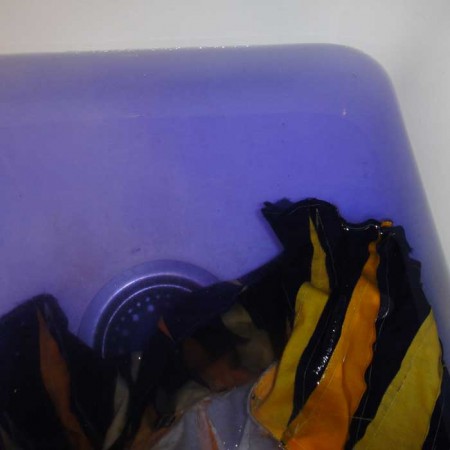
Oh! One last thing! Look what happened to my blue fabric when I submerged it in water to dissolve the Paper Solvy! And that was after prewashing it once! The remainder of that fabric is going back in the washer immediately. Thankfully, no dye transferred to the white or yellow fabrics. (Update: Oops! I spoke too soon!)
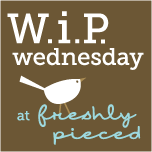 I’m linking this to Freshly Pieced’s Work in Progress Wednesday. If you’re reading my blog for the first time, you can read the rest of the step-by-step progress of this quilt by looking at the posts in the “Glorious” category.
I’m linking this to Freshly Pieced’s Work in Progress Wednesday. If you’re reading my blog for the first time, you can read the rest of the step-by-step progress of this quilt by looking at the posts in the “Glorious” category.
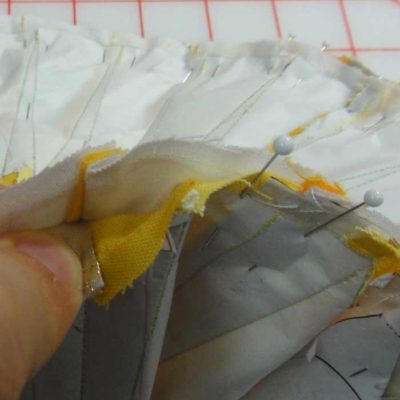
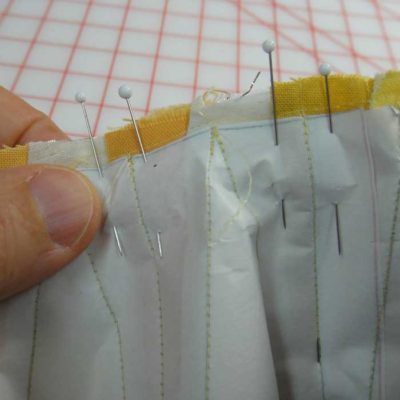
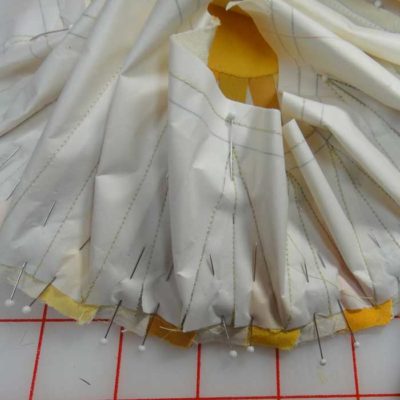
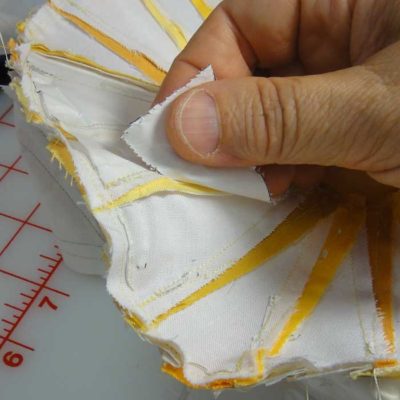
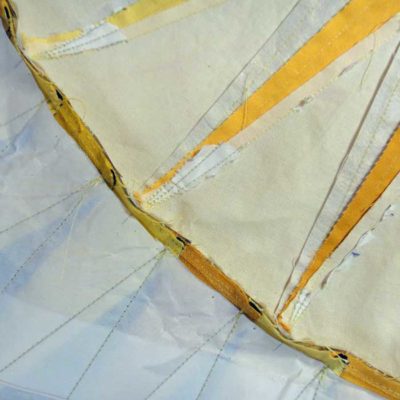


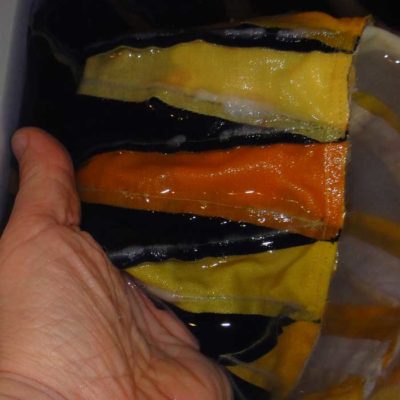
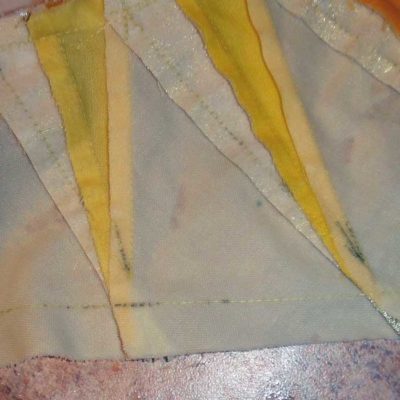
Comments
6 responses to “Product review: Sulky Paper Solvy”
I used the Solvy once…I transferred on of Lesa Bame’s “Zentangle” sketches and used it to practice free-motion quilting…I used white thread on black fabric…there was not enough left to tear away, but while washing out the paper I decided to leave the residue around the stitching…got a neat fuzzy effect…
On paper pieceing…Janice took George Sicliano’s workshop and does foundation pieceing and has a foundation sheet that is left in…seems fairly light…
I am anxious to see your “Glorious” piece next week…don’t know if I will get mine done or not…too many irons in the fire (and it does not burn to vigorously…)…
Interesting. I’ve never even heard of this project, so am glad to. Looks like a lovely project in progress!
There is a product called Fun-dation Paper Piecing sheets that are more like Pellon stabilizer but 8 1/2″ x 11″ and can be run through an inkjet printer. It advertises it can be torn away or left in; the reviewers say it’s difficult to tear away, so recommend leaving it in. JoAnn’s sells it online and they used to have it in the store, but I don’t recall seeing it recently. Of course it’s a bit pricey. I use 16-lb paper I bought at Marco’s Paper on Whipp Road near Far Hills – $2 for a ream of 500! Just ask for the thin paper people use for quilt paper piecing. It only comes punched for 3 holes for some reason, but it’s nice and thin and tears away the best of any plain old paper I’ve used. And the price is right. : )
Ann, thanks for letting me know! I think I’ve seen the Fun-dation sheets, but had forgotten about them. I probably have them in my studio somewhere. Since I’m in use-it-up mode, I should go looking for them and then come up with a project to use them! The tip about Marco’s Paper is great, too. I’ll take any excuse to go there 🙂
thank you for the review. that piecing looks complicated!
Turns out it looks more complicated that it really was…don’t love love patterns like that?!!! All the kudos with less work 🙂